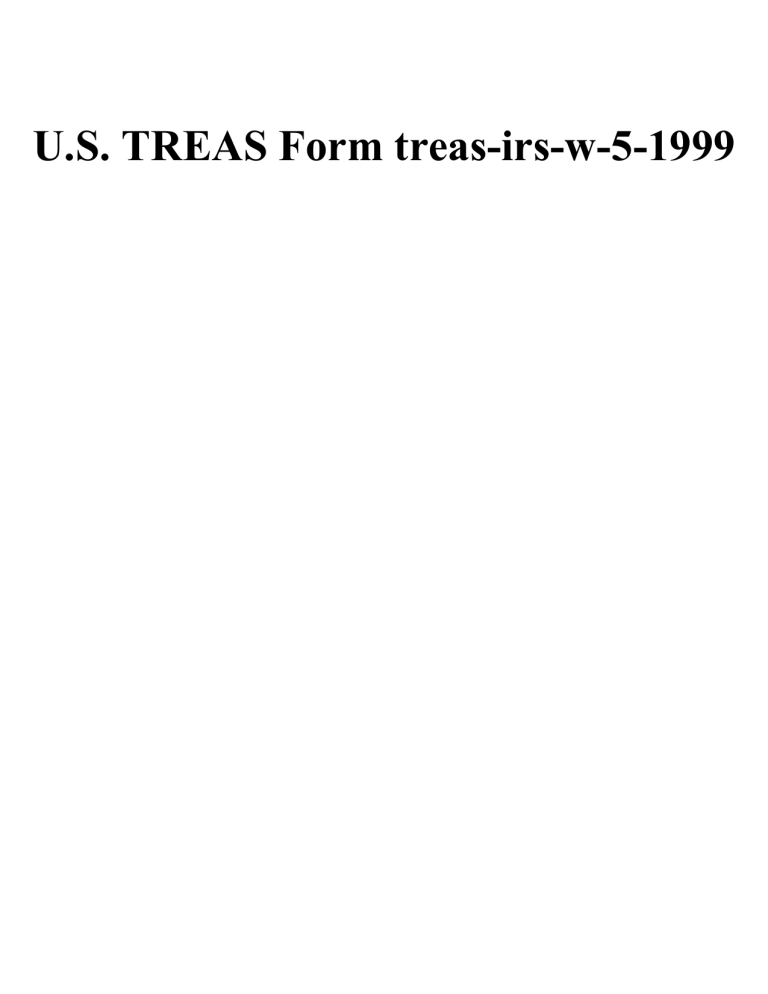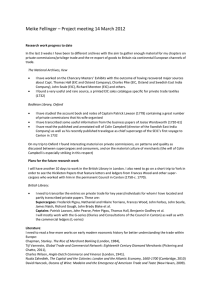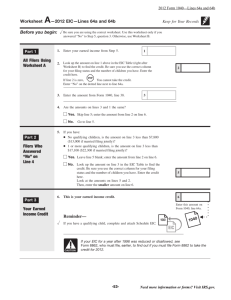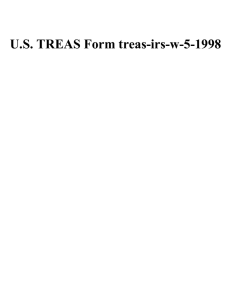U.S. TREAS Form treas-irs-w-5-1999

U.S. TREAS Form treas-irs-w-5-1999
19 99 Form W-5
Instructions
Purpose
Use Form W-5 if you are eligible to get part of the EIC in advance with your pay and choose to do so. The amount you can get in advance generally depends on your wages. If you are married, the amount of your advance EIC payments also depends on whether your spouse has filed a Form W-5 with his or her employer.
However, your employer cannot give you more than
$1,387 throughout 1999 with your pay.
If you do not choose to get advance payments, you can still claim the EIC on your 1999 tax return.
What Is the EIC?
The EIC is a credit for certain workers. It reduces tax you owe. It may give you a refund even if you do not owe any tax. For 1999, the EIC can be as much as
$2,312 if you have one qualifying child or $3,816 if you have more than one qualifying child. If you do not have a qualifying child, you may still be eligible for a credit of up to $347, but you cannot receive advance EIC payments. See Who Is a Qualifying Child? on page 2.
Who Is Eligible To Get Advance EIC
Payments?
You are eligible to get advance EIC payments if all
three of the following apply.
1. You have at least one qualifying child.
2. You expect that your 1999 earned income and modified AGI (adjusted gross income) will each be less than $26,928. Include your spouse’s income if you plan to file a joint return. As used on this form, earned
Department of the Treasury
Internal Revenue Service
income does not include amounts inmates in penal institutions are paid for their work or workfare payments (defined below). For most people, modified
AGI is the same as adjusted gross income. But see the
1998 revision of Pub. 596, Earned Income Credit, for information about how to figure your 1999 modified
AGI if you expect to receive tax-exempt interest; nontaxable payments from a pension, annuity, or an
IRA; or you plan to file a 1999 Form 1040.
3. You expect to be able to claim the EIC for 1999.
To find out if you may be able to claim the EIC, answer the questions on page 2.
Workfare payments. These are cash payments certain families receive from a state or local agency that administers public assistance programs funded under the Federal Temporary Assistance for Needy Families program in return for (1) work experience activities
(including work associated with remodeling or repairing publicly assisted housing) if sufficient private sector employment is not available, or (2) community service program activities.
How To Get Advance EIC Payments
If you are eligible to get advance EIC payments, fill in the 1999 Form W-5 at the bottom of this page. Then, detach it and give it to your employer. If you get advance payments, you must file a 1999 Federal income tax return.
You may have only one Form W-5 in effect at one time. If you and your spouse are both employed, you should file separate Forms W-5.
(Continued on page 2)
� Give the lower part to your employer; keep the top part for your records. �
Detach here
Form
W-5
Department of the Treasury
Internal Revenue Service
Type or print your full name
Earned Income Credit Advance Payment Certificate
OMB No. 1545-1342
� Use the current year’s certificate only.
� Give this certificate to your employer.
� This certificate expires on December 31, 1999.
19 99
Your social security number
Note: If you get advance payments of the earned income credit for 1999, you must file a 1999 Federal income tax return. To get advance payments, you must have a qualifying child and your filing status must be any status except married filing a separate return.
Yes No
1 I expect to be able to claim the earned income credit for 1999, I do not have another Form W-5 in effect with any other current employer, and I choose to get advance EIC payments
2 Do you have a qualifying child?
3 Are you married?
4 If you are married, does your spouse have a Form W-5 in effect for 1999 with any employer?
Under penalties of perjury, I declare that the information I have furnished above is, to the best of my knowledge, true, correct, and complete.
Signature � Date �
Cat. No. 10227P
Form W-5 (1999) Page
2
Questions To See if You May Be Able To Claim the EIC for 1999
Caution: You cannot claim the EIC if you plan to file either Form 2555 or Form 2555-EZ (relating to foreign ear ned income) for
1999. You also cannot claim the EIC if you are a nonresident alien for any part of 1999 unless you are marr ied to a U.S. citizen or resident and elect to be taxed as a resident alien for all of 1999.
1 Do you have a qualifying child? Read Who Is a Qualifying Child? that starts below before you answer this question. If the child is married, be sure you also read Married child on page 3.
No. Stop. You may be able to claim the EIC but you cannot get advance EIC payments.
Yes. Go to question 2.
Caution: If the child is a qualifying child for both you and another person, you can treat the child as your qualifying child only if you expect your 1999 modified AGI to be higher than the other person’s modified AGI. If the other person is your spouse and you expect to file a joint retur n for 1999, this rule does not apply.
2 Do you expect your 1999 filing status to be Married filing a separate return?
Yes. Stop. You cannot claim the EIC.
No. Go to question 3.
If you expect to file a joint retur n for 1999, include your spouse’s income when answer ing questions 3 and 4.
3 Do you expect that your 1999 earned income and modified AGI (see page 1) will each be less than $26,928 (less than $30,580 if you have more than one qualifying child)?
No. Stop. You cannot claim the EIC.
Yes. Go to question 4. But remember, you cannot get advance EIC payments if you think your 1999 earned income or modified AGI will be $26,928 or more.
4 Do you expect that your 1999 investment income will be more than $2,350? For most people, investment income is the total of their taxable interest and dividends and tax-exempt interest. However, if you plan to file a 1999 Form 1040, see the 1998
Form 1040 instructions to figure your investment income.
Yes. Stop. You cannot claim the EIC.
No. Go to question 5.
5 Do you expect that you (or your spouse if filing a joint return) will be a qualifying child of another person for 1999?
No. You may be able to claim the EIC.
Yes. You cannot claim the EIC.
This Form W-5 expires on December 31, 1999. If you are eligible to get advance EIC payments for 2000, you must file a new Form W-5 next year.
You may be able to get a larger credit when you file your 1999 retur n. For details, see Additional
Credit on page 3.
Who Is a Qualifying Child?
Any child who meets all three of the following conditions is a qualifying child.
1. The child is your son, daughter, adopted child, stepchild, foster child, or a descendant (for example, your grandchild) of your son, daughter, or adopted child.
Form W-5 (1999)
Note: An adopted child includes a child placed with you by an author ized placement agency for legal adoption even if the adoption is not final. A foster
child is any child you cared for as your own child.
2. The child is under age 19 at the end of 1999, or under age 24 at the end of 1999 and a full-time student, or any age at the end of 1999 and permanently and totally disabled.
3. The child lives with you in the United States for over half of 1999 (for all of 1999 if a foster child). If the child does not live with you for the required time because the child was born or died in 1999, the child is considered to have lived with you for all of 1999 if your home was the child’s home for the entire time he or she was alive in 1999.
Note: Temporary absences such as for school, medical care, or vacation count as time lived at home.
Members of the military on extended active duty outside the United States are considered to be living in the United States.
Married child. If the child is married at the end of
1999, that child is a qualifying child only if you may claim him or her as your dependent, or the following
Exception applies to you.
Exception. You are the custodial parent and would be able to claim the child as your dependent, but the noncustodial parent claims the child as a dependent because—
1. You signed Form 8332, Release of Claim to
Exemption for Child of Divorced or Separated Parents, or a similar statement, agreeing not to claim the child for 1999, or
2. You have a pre-1985 divorce decree or separation agreement that allows the noncustodial parent to claim the child and he or she gives at least $600 for the child’s support in 1999.
Qualifying child of more than one person. If the child is a qualifying child of more than one person, only the person with the highest modified AGI for 1999 may treat that child as a qualifying child. If the other person is your spouse and you plan to file a joint return for
1999, this rule does not apply.
Reminder. Your qualifying child must have a social security number.
What if My Situation Changes?
If your situation changes after you give Form W-5 to your employer, you will probably need to file a new
Form W-5. For example, you should file a new Form
W-5 if any of the following applies for 1999.
●
You no longer have a qualifying child. Check “No” on line 2 of your new Form W-5.
● You no longer expect to be able to claim the EIC for
1999. Check “No” on line 1 of your new Form W-5.
●
You no longer want advance payments. Check “No” on line 1 of your new Form W-5.
Page
3
● Your spouse files Form W-5 with his or her employer.
Check “Yes” on line 4 of your new Form W-5.
Note: If you get the EIC with your pay and find you are not eligible, you must pay it back when you file your
1999 Federal income tax retur n.
Additional Information
How To Claim the EIC
If you are eligible, claim the EIC on your 1999 tax return. See your 1999 instruction booklet.
Additional Credit
You may be able to claim a larger credit when you file your 1999 tax return because your employer cannot give you more than $1,387 of the EIC throughout the year with your pay. You may also be able to claim a larger credit if you have more than one qualifying child.
But you must file your 1999 tax return to claim any additional credit.
Privacy Act and Paperwork Reduction Act Notice.
We ask for the information on this form to carry out the Internal Revenue laws of the United States.
Internal Revenue Code sections 3507 and 6109 and their regulations require you to provide the information requested on Form W-5 and give the form to your employer if you want advance payment of the EIC. As provided by law, we may give the information to the
Department of Justice and other Federal agencies. In addition, we may give it to cities, states, and the
District of Columbia so they may carry out their tax laws.
You are not required to provide the information requested on a form that is subject to the Paperwork
Reduction Act unless the form displays a valid OMB control number. Books or records relating to a form or its instructions must be retained as long as their contents may become material in the administration of any Internal Revenue law. Generally, tax returns and return information are confidential, as required by Code section 6103.
The time needed to complete this form will vary depending on individual circumstances. The estimated average time is: Recordkeeping, 7 min.; Learning
about the law or the form, 11 min.; and Preparing
the form, 27 min.
If you have comments concerning the accuracy of these time estimates or suggestions for making this form simpler, we would be happy to hear from you.
You can write to the Tax Forms Committee, Western
Area Distribution Center, Rancho Cordova, CA
95743-0001. DO NOT send the form to this address.
Instead, give it to your employer.


